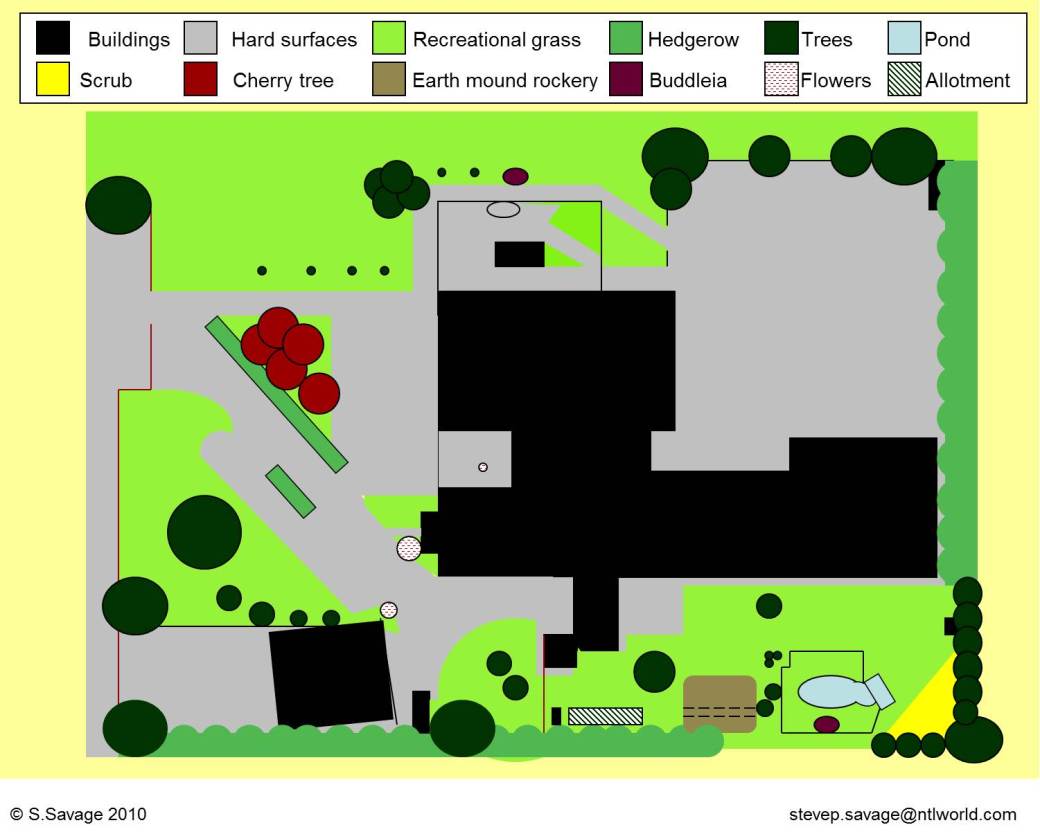SCHOOL GROUNDS HABITAT MAPPING
A basis for school ground development, helping wildlife and creating teaching resources.
School grounds can provide important sanctuaries for wildlife and at the same time provide excellent opportunities for engaging pupils with the natural world through the curriculum.
Background. I first started working in school with school grounds while working as education officer in a public aquarium in 1986, focusing on adding water to school grounds, from ponds to bird baths. Since then I have worked with schools in many different capacities from advising on habit mapping, school ground development and running sessions on mini-beasts, birds and other wildlife in the grounds. To increase the value of the session I encouraged schools to create a simple map of their grounds as a pre-visit to mark the position of the animals found during the session. In 2006 I developed a pilot of the current habitat mapping project, using my garden as a case study and showcased at Sustainable schools conference in 2007, and school case were created while working in partnership with the Sussex Wildlife Trust and Brighton & Hove Council School Grounds BAP Project. I have continued to develop further opportunities from this original concept. I continue to use my garden to test out new ideas before I recommend them to schools.
See also free CPD for teachers ‘Mapping Your Patch Of Nature’ 26/01/21 detailed on the Events Page
HABITAT MAPPING
The main aim of this mapping project is to provide a template that will help schools to develop an understanding of their grounds and build up a teaching resource that can be contributed to and used by all classes within the school and also use this knowledge to help inform discussion for developing school grounds for wildlife and monitoring the results through classroom topics. For example, children can survey the grounds to learn about bees in the grounds. This may lead to creation of a bee-garden. The success of the bee-garden can be measured the following year by children as part of their bee investigation.

The school grounds map will aid exploration and help raise awareness of connectivity of habitats within the grounds and connectivity with the area around the school grounds. Much of the wildlife you will find in your school grounds is due to this connectivity.
Information can be built up and used by future year group, shared with other years groups, used in a cross curriculum. It can bring together and involve other areas of the school community, such as science clubs, eco-clubs and gardening clubs.
The map can be used to plan and undertake good science skills that the children can evaluate themselves as they will be able to find the answer by re-visiting the schools grounds.
Background. I first started working in school with school grounds while working as education officer in a public aquarium in 1986, focusing on adding water to school grounds, from ponds to bird baths. Since then I have worked with schools in many different capacities from advising on habit mapping, school ground development and running sessions on mini-beasts, birds and other wildlife in the grounds. To increase the value of the session I encouraged schools to create a simple map of their grounds as a pre-visit to mark the position of the animals found during the session. In 2006 I developed a pilot of the current habitat mapping project, using my garden as a case study and showcased at Sustainable schools conference in 2007, and school case were created while working in partnership with the Sussex Wildlife Trust and Brighton & Hove Council School Grounds BAP Project. I have continued to develop further opportunities from this original concept. See also free CPD for teachers ‘Mapping Your Patch Of Nature’ 26/01/21 detailed on the Events Page
SOME FEEDBACK
“ We found out how the birds visiting our school grounds enter and move around using bird flight paths. This will help with the development of our grounds for birds. We will add water, bird feeders and nest box in places we have seen the birds – on these bird flight paths through the grounds”
“The bee map we made helped us to find out what flowers in our school the bees liked”
“I did not know that wasps are good for gardens and eat pests.”
“I found out that we had a toad living in our grounds”